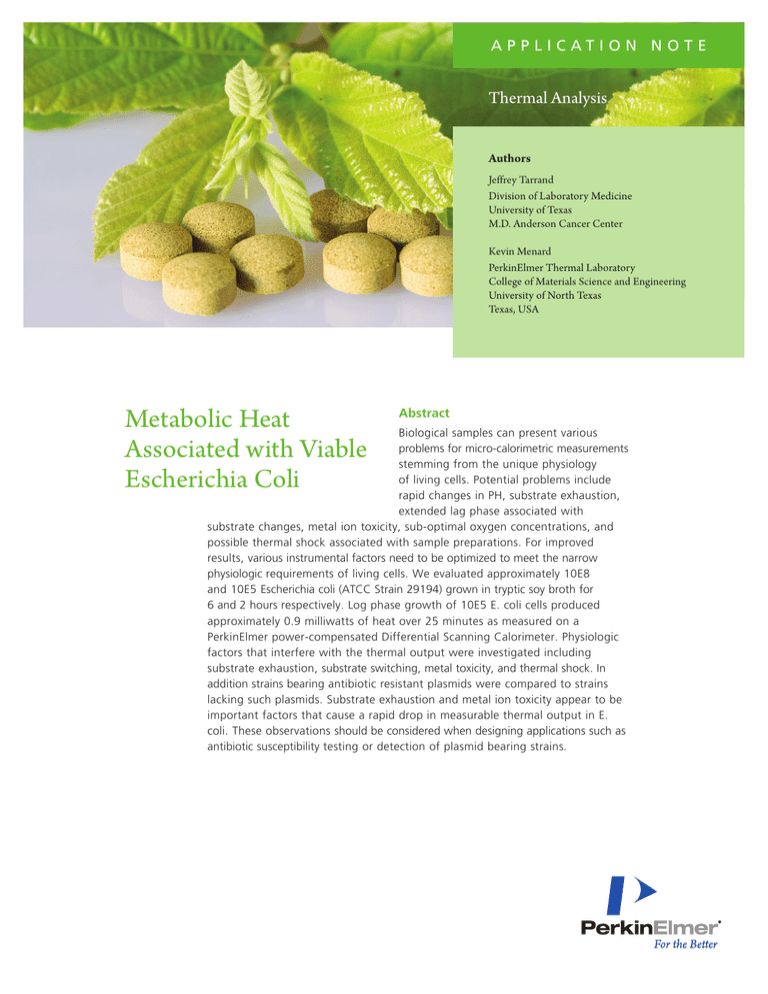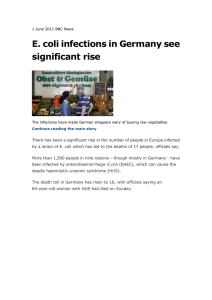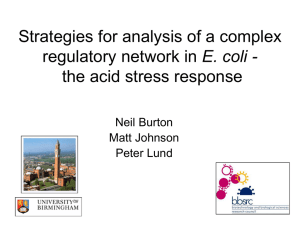
a p p l i c at i o n N o t e
Thermal Analysis
Authors
Jeffrey Tarrand
Division of Laboratory Medicine
University of Texas
M.D. Anderson Cancer Center
Kevin Menard
PerkinElmer Thermal Laboratory
College of Materials Science and Engineering
University of North Texas
Texas, USA
Metabolic Heat
Associated with Viable
Escherichia Coli
Abstract
Biological samples can present various
problems for micro-calorimetric measurements
stemming from the unique physiology
of living cells. Potential problems include
rapid changes in PH, substrate exhaustion,
extended lag phase associated with
substrate changes, metal ion toxicity, sub-optimal oxygen concentrations, and
possible thermal shock associated with sample preparations. For improved
results, various instrumental factors need to be optimized to meet the narrow
physiologic requirements of living cells. We evaluated approximately 10E8
and 10E5 Escherichia coli (ATCC Strain 29194) grown in tryptic soy broth for
6 and 2 hours respectively. Log phase growth of 10E5 E. coli cells produced
approximately 0.9 milliwatts of heat over 25 minutes as measured on a
PerkinElmer power-compensated Differential Scanning Calorimeter. Physiologic
factors that interfere with the thermal output were investigated including
substrate exhaustion, substrate switching, metal toxicity, and thermal shock. In
addition strains bearing antibiotic resistant plasmids were compared to strains
lacking such plasmids. Substrate exhaustion and metal ion toxicity appear to be
important factors that cause a rapid drop in measurable thermal output in E.
coli. These observations should be considered when designing applications such as
antibiotic susceptibility testing or detection of plasmid bearing strains.
Introduction
Micro-calorimetric measurements of metabolic heat derived
from viable bacterial cells has found application in the food,
pharmaceutical, and medical diagnostic industries as well as
in the studies of environmental and soil microbiology.1,2
The method shows particular promise for the analysis of
slow growing microorganisms where typical bioassays for
drug susceptibility may require weeks or months.3,4 Typical
bioassays used in clinical laboratories rely on highly reproducible physiologic conditions to allow interpretations of
bacterial growth response; for example changes on growth
in response to an antimicrobial agent require precisely
reproducible cation concentrations. The physiology of
bacterial respiration has been well studied.
10E6 E. coli consume approximately 125 micro-liters of
oxygen at 37 ˚C under aerobic conditions.5 These physiologic
requirements have not been extensively studied in the effect
of substrate exhaustion, metal ion toxicity, thermal shock,
and substrate switching on bacterial respiration as measured
by the heat release in a power compensation DSC.
Experimental
Strains: Escherichia coli strain ATCC 29194 (Figure 1)
was used in studies of heat shock, metal ion toxicity, and
substrate exhaustion. A sucrose positive laboratory strain
(H1) was used to demonstrate substrate switching. A second
laboratory strain (P1) with and without 12 kb plasmid was
used to demonstrate the effects of plasmid on thermal
output. All strains were grown overnight in tryptic soy broth
and then were sub cultured in tryptic broth for 2 hours at
37 ˚C with an oscillatory shaker at 100 cpm. Six hour cultures
were prepared in experiments on substrate exhaustion.
Thermal Analysis: Micro-calorimetric measurements were
made under isothermal conditions at 37 ˚C except where
mentioned in the text. Micro-calorimetric measurements
were made using a PerkinElmer power compensated DSC-7.
This DSC’s low mass furnaces and power compensation gave
outstanding sensitivity to small changes and the instrument
is well known for its isothermal stability. The reaction cells
were held under nitrogen, air or oxygen atmospheres. The
DSC was held at 37 ˚C and baseline subtraction was used.
Runs were performed in triplicate and averaged to account
for biological variability. Baselines showed a drift of +0.143 mW
over 25 minutes with substrates in both cells. All other heat
flows reported in this work are exothermic. A high pressure
accessory from PerkinElmer was used for evaluated pressure
work. Bacterial samples were assayed in tryptic soy broth
and compared to a reference cell containing uninoculated
tryptic soy broth and substrate. Unless otherwise specified,
all sample volumes were 50 micro liters of solution containing
10E7 E. coli in log phase growth. All samples were run in
aluminum pans unless otherwise noted.
2
Figure 1. Escherichia coli.
Results
Initial studies on 10E5 E. coli produced approximately -0.9 mW
of heat over a 25 minute interval. This is in contrast to
where the same innoculum of cells grown at 37 ˚C were
shocked by exposure to 40 ˚C. Apparent metabolism is
reduced to -0.05 mW in 25 minutes and does not recover
over the time interval studied.
Figure 2 shows a higher degree of thermal output (-29 mW)
associated with a heavy innoculum of 10E7 cells. The slope
shows a gradual decrease with time. When 10E7 cells are
grown under nitrogen atmosphere, less heat (-12 mW) is
generated than when an air purge is used. This is shown
in Figure 3. Use of higher concentration of oxygen did not
increase the heat generated as neither pure oxygen nor 10 bar
oxygen pressure caused an increase in metabolic heat.
An innoculum of 10E7 cells from an 18 hour old culture was
prepared and would be expected to be in a stationary state
of growth. In Figure 4, this stationary phase growth and
fresh media containing a low amount of glucose (0.01%)
were mixed 1:1. Initial heat generation was slow but a brief
burst of metabolism occurred as the glucose was utilized
and then exhausted. It might be anticipated that induction
of metabolic pathways required for the utilization of
different substrates could generate a similar lag phenomenon
but using sucrose and maltose substrates, we were unable
to demonstrate any lag in heat production within the time
frame studied.
The selection of different sample pans has a significant
effect on the thermal output from the E.coli. When aluminum
pans were used, 10E7 cells produced approximately -29 mW
of heat in 15 minutes. In contrast, when stainless steel
or gold pans were used, the thermal output immediately
dropped to -1.9 and -0.6 mW respectively. A summary of
effects is presented in Table 1.
Discussion and Conclusions
In E. Coli, 42 ˚C typically induces the expression of heat
shock proteins that allows the organism to survive at adverse
temperature.5,6 During the DSC scans, itd metabolism was
observed to promptly decrease even at temperatures well
within the growth range of E. coli. This prolonged
period required for adjustment to a new temperature is
referred to as thermal shock. In our experiments, metabolism
decreased by approximately 20 fold on exposure to 40 ˚C.
A heavy innoculum produced greater thermal output than a
light innoculum but the slope gradually decreased presumably
due to substrate exhaustion. In the design of thermal assays,
this would mean that the ratios of low innocula to high
innocula might not yield strictly proportional thermal gain.
In an extreme example some lag time might be required
before the substrate can be utilized (Figure 4). Thus proportional or kinetic antimicrobial methods might require strict
standardization of the innocula when performing thermal
methods. We were unable to demonstrate any lag with
substrate switching. The complex tryptic soy broth may
provide other metabolic substrates used in addition to
and perhaps in preference to the sugars tested.
Figure 2. DSC on 10e7 E. coli in air.
Figure 4. Substrate-induced lag time.
We tested an E. coli strain containing a 12 kb plasmid and a
variant of the same strain that had lost the plasmid.7 Only a
10% increase in thermal output was seen. However, unlike
the other experiments where conditions were compared
using the same innocula, this required using 2 different
innocula. Thus the 10% difference could be due to the
effect of the plasmids on metabolic efficiency or a mismatch
in innoculum size. Further work is needed to validate this.
Perhaps the most significant condition affecting the physiology
of the viable E. coli was the choice of sample pan material. Both
stainless steel and gold pans proved to be highly inhibitory to
bacterial metabolism. The toxic effect of heavy metals in E. coli
is well known and it appears even brief contact of the aqueous
solutions with the stainless steel and gold pans results in sufficient metal ion concentration to inhibit E. coli metabolism.
In summary, of the several factors studied heavy metal ion
contamination and substrate exhaustion were the most
important factors in determining the metabolic response of
rapidly growing E. coli in a thermal analysis format. These
physiological factors must be considered in future applications with live microorganisms since high concentrations of
the organism are used to maximize the thermal signal in a
rapid bioassay format.
Table 1. Summary of effects on metabolic heat.
E. coli
Figure 3. DSC on 10e7 E. coli in N2.
Gas
Pan
Temp. Heat Flow1
10E5 air
Aluminum37 -0.9
10E5 air
Aluminum40 -0.05
10e7 air
Aluminum37 -29.1
10e7N2
Aluminum37 -18.3
10e7O2
Aluminum37 -17.6
10e7O2, 10 bar
Aluminum
37
-19.2
10e7 with
plasmidsair
Aluminum
37
-32.1
10e7
-1.9
Stainless steel
37
10e7air
Gold
37-0.6
baselineair
Aluminum
37
1
air
+0.1
heat flow as mW per 25 minutes, averaged from three runs.
3
References
1. Beezer, A.E. (Editor), Biological Microcalorimetry, Academic
Press, NY, 1980.
2. Redl, B. et al., J. Appl/ Microbiol. Biotechnol. 1991, 12, 234.
3. Limb, D.I. et al., J. Clin. Pathol., 1993, 46, 403.
4. Hoffener, S.E. et al., J. Antimicrob. Chemotherapy, 1990,
25, 353.
5. Kiehn, T.E., Clinical Infectious Diseases, 1993, 17, S447.
6. Ajl, S. L., J. Bacteriol., 1950, 59, 499.
7. Russel, W.J. et al. in Microbiology, Schlessinger, D. (Editor),
American Society for Microbiology, Washington D.C., 22, 1985.
PerkinElmer, Inc.
940 Winter Street
Waltham, MA 02451 USA
P: (800) 762-4000 or
(+1) 203-925-4602
www.perkinelmer.com
For a complete listing of our global offices, visit www.perkinelmer.com/ContactUs
Copyright ©2011-2012, PerkinElmer, Inc. All rights reserved. PerkinElmer® is a registered trademark of PerkinElmer, Inc. All other trademarks are the property of their respective owners.
009942_01




